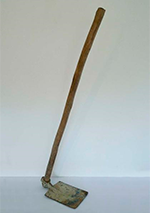Mission to impregnate “soul” in a hoe
Between the Christian Cruise and the Kurusu
DOI:
https://doi.org/10.15381/espiral.v1i2.17146Keywords:
cross, guarani, indigenism, postcolonial art, monotypeAbstract
A digression between two cross-shaped liturgical objects captures different ways of relating to time and space. The contrast between aspects imbued in the treatment with the Christian cruise and the «kurusu» - which indicates graves of Guarani-Kaiowá Amerindians relatives and ancestors - reveals different ways in which the body copes with the surrounding reality. How to evade the current prevailing logic, that generates oppressive scenarios such as the existing in the state of Mato Grosso do Sul, Brazil, where Guarani-Kaiowá barely survive? To seek for some resolutive inspiration, the present reflection endeavors to devise ways to immerse itself in the Indigenous worldview. As a proposal, the individual performs an effort to be intrigued by the “skin permeability”, that is, to be aware of the significant “distractions” introduced in the present. This behavior is thus understood as a way of feeling ecologically and socially, sustainable and responsible.

Downloads
Published
Issue
Section
License
Copyright (c) 2019 Letícia Larin Platzeck Senra

This work is licensed under a Creative Commons Attribution-NonCommercial-ShareAlike 4.0 International License.
LOS AUTORES RETIENEN SUS DERECHOS:
a. Los autores retienen sus derechos de marca y patente, y también sobre cualquier proceso o procedimiento descrito en el artículo.
b. Los autores retienen el derecho de compartir, copiar, distribuir, ejecutar y comunicar públicamente el artículo publicado en la revista Espiral (por ejemplo, colocarlo en un repositorio institucional o publicarlo en un libro), con un reconocimiento de su publicación inicial en la revista Espiral.
c. Los autores retienen el derecho a hacer una posterior publicación de su trabajo, de utilizar el artículo o cualquier parte de aquel (por ejemplo: una compilación de sus trabajos, notas para conferencias, tesis, o para un libro), siempre que indiquen la fuente de publicación (autores del trabajo, revista, volumen, número y fecha).





